India’s landscape is dotted with magnificent forts and opulent palaces, each telling a tale of valor, grandeur, architectural brilliance, and the ebb and flow of empires. These structures are not merely defensive fortifications or royal residences; they are living testaments to India’s rich history, diverse cultures, and sophisticated engineering skills. This report details some of the most iconic and historically significant castles, forts, and palaces across the country, based on verified and credible sources.
1. Mehrangarh Fort, Jodhpur, Rajasthan

Location: Jodhpur, Rajasthan Historical Background and Date of Construction: Mehrangarh Fort, meaning “Sun Fort,” looms majestically over the city of Jodhpur, perched on a 410-foot high hill. Its construction was initiated by Rao Jodha, the Rathore ruler and founder of Jodhpur, in 1459 when he shifted his capital from Mandore. Over subsequent centuries, various rulers added to its structure, leading to the sprawling complex seen today.
Dynasties or Kings Who Built and Ruled It:
- Rathore Dynasty: Built and ruled by the Rathore clan of Rajputs, beginning with Rao Jodha. Successive rulers like Maharaja Ajit Singh, Maharaja Gaj Singh, and Maharaja Hanwant Singh contributed to its expansion and embellishment.
Architectural Style and Special Features: Mehrangarh Fort is a superb example of Rajput architecture, characterized by its imposing size, intricate carvings, and harmonious blend of defensive strength with aesthetic beauty.
- Imposing Walls: The fort is enclosed by formidable walls, up to 120 feet high and 69 feet wide at points, with several bastions.
- Seven Gates: Entry is through a series of seven massive gates, each with historical significance:
- Jai Pol (Victory Gate): Built by Maharaja Man Singh in 1806 to commemorate his victories over Jaipur and Bikaner armies.
- Fateh Pol (Victory Gate): Built by Maharaja Ajit Singh to mark his triumph over the Mughals.
- Loha Pol (Iron Gate): The final inner gate, notable for the sati (self-immolation) handprints of royal widows.
- Palaces within the Fort: Houses several exquisitely carved palaces:
- Moti Mahal (Pearl Palace): The royal audience hall.
- Phool Mahal (Flower Palace): A grand reception hall with stained glass windows and gilded ceilings.
- Sukh Mahal (Pleasure Palace): Designed for relaxation, with elaborate latticework screens.
- Takhat Vilas: Maharaja Takhat Singh’s chamber, showcasing rich paintings.
- Courtyards and Galleries: Spacious courtyards, such as the Daulat Khana and Sileh Khana, and intricate galleries.
- Water Harvesting: Features sophisticated water harvesting systems, essential for a desert fort.
Important Battles or Historical Events: Mehrangarh Fort has witnessed numerous sieges and battles throughout its history, primarily against the Mughal Empire and rival Rajput states. Its strong defenses often proved impregnable. The marks of cannonball hits can still be seen on its walls.
Current Condition and Conservation Status: The Mehrangarh Fort is exceptionally well-preserved and actively managed by the Mehrangarh Museum Trust. It is considered one of the best-maintained forts in India.
Tourism and Visitor Information: The fort is a major tourist attraction in Rajasthan.
- Museum: Houses an extensive museum displaying royal palanquins, arms, costumes, paintings, and traditional instruments.
- Cultural Events: Hosts various cultural festivals, including the Rajasthan International Folk Festival and the World Sufi Spirit Festival.
- Panoramic Views: Offers breathtaking panoramic views of the “Blue City” of Jodhpur.
- Accessibility: Easily accessible from Jodhpur city by road.
2. Amber Fort, Jaipur, Rajasthan
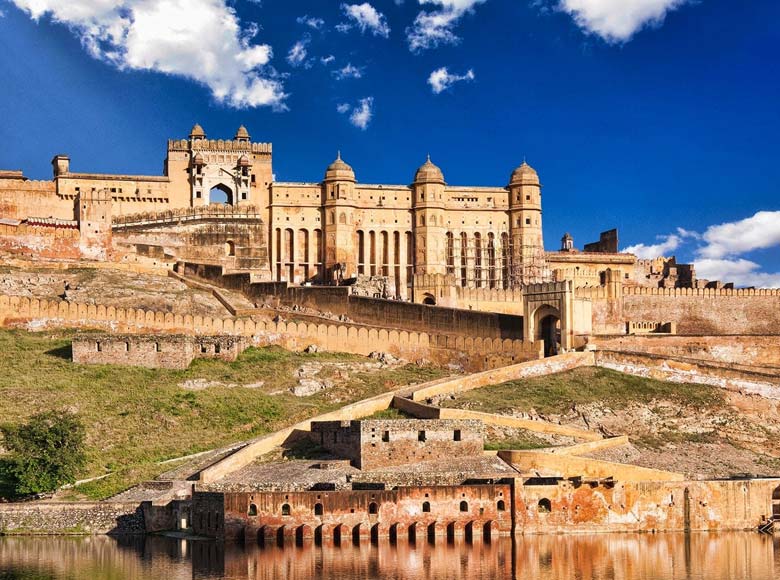
Location: Jaipur, Rajasthan Historical Background and Date of Construction: Amber Fort (also known as Amer Fort) is located about 11 kilometers from Jaipur. Its construction was commenced in 1592 by Raja Man Singh I, the Rajput ruler of Amber and a trusted general of Emperor Akbar. The fort underwent significant additions and renovations by successive Kachwaha rulers over approximately two centuries.
Dynasties or Kings Who Built and Ruled It:
- Kachwaha Dynasty of Amber/Jaipur: Raja Man Singh I, Jai Singh I (Mirza Raja Jai Singh), and Sawai Jai Singh II were key rulers who contributed to its development. It served as the capital of the Kachwaha Rajputs before Jaipur was founded.
Architectural Style and Special Features: Amber Fort is a splendid example of Rajput and Mughal architectural fusion, reflecting the close alliances and cultural exchange between the Kachwahas and the Mughals. It is part of the Hill Forts of Rajasthan UNESCO World Heritage Site (2013).
- Layout: Built on four levels, each with a courtyard, it combines residential palaces, halls, and gardens.
- Sheesh Mahal (Mirror Palace): One of its most famous features, adorned with thousands of tiny mirrors and colored glass, creating a dazzling effect when lit.
- Diwan-i-Aam (Hall of Public Audience): A grand hall with double rows of columns, where the king met commoners.
- Diwan-i-Khas (Hall of Private Audience): For private consultations, with intricate floral carvings and glass mosaics.
- Ganesh Pol: An exquisite gate leading to the private palaces, adorned with a painting of Lord Ganesha.
- Sukh Niwas (Hall of Pleasure): Designed to remain cool with an artificial cascade of water running through it.
- Hammam: Royal baths, demonstrating sophisticated water management.
- Jalebi Chowk: The main courtyard where the king’s army held parades.
- Kesar Kyari Garden: A beautiful saffron garden in the center of Maota Lake, adding to the fort’s picturesque setting.
Important Battles or Historical Events: Amber Fort, being the seat of powerful Rajput rulers who were often allied with the Mughals, did not face many direct sieges once the alliance was solidified. Its strength lay more in political alliances than constant warfare. It remained the capital until Sawai Jai Singh II founded the new city of Jaipur in 1727.
Current Condition and Conservation Status: Amber Fort is exceptionally well-maintained and is a major tourist destination. It is a UNESCO World Heritage site, which ensures high standards of conservation and management by the Archaeological Survey of India (ASI) and the Rajasthan State Department of Archaeology and Museums.
Tourism and Visitor Information:
- Elephant Rides: A popular way to ascend the fort (though ethical concerns about elephant welfare are increasingly raised).
- Sound and Light Show: Held in the evenings, narrating the history of the fort and the Kachwaha dynasty.
- Museum and Shops: Within the fort, offering souvenirs and traditional crafts.
- Accessibility: Easily reached from Jaipur by road.
3. Gwalior Fort, Gwalior, Madhya Pradesh

Location: Gwalior, Madhya Pradesh Historical Background and Date of Construction: Gwalior Fort is one of the oldest and most formidable forts in India, often referred to as “the pearl in the necklace of the forts of Hind” by Emperor Babur. Its origins are ancient, dating back to at least the 6th century CE. The exact date of its initial construction is debated, but inscriptions suggest its existence since the 5th century. It has been rebuilt, modified, and expanded by numerous dynasties.
Dynasties or Kings Who Built and Ruled It: Gwalior Fort has been ruled by a succession of powerful dynasties:
- Gurjara-Pratiharas: Early rulers.
- Tomars: Most notably, Man Singh Tomar (1486–1516), who built the magnificent Man Singh Palace.
- Mughals: Under Akbar and Aurangzeb, it served as a state prison for political prisoners and rival heirs.
- Ranas of Gohad: Briefly controlled it.
- Marathas (Scindias): Recaptured and held the fort, making it a prominent center.
- British: Temporarily held it after the First Opium War and during the 1857 Mutiny.
Architectural Style and Special Features: Gwalior Fort displays a blend of Hindu and Indo-Islamic architectural styles, reflecting its long and diverse history.
- Two Main Parts: The fort has two main parts: Gujari Mahal and Man Singh Palace.
- Man Singh Palace: Built by Man Singh Tomar, this is a masterpiece of early Hindu architecture, famous for its blue tilework, intricate carvings, and unique features like the Jauhar Kund (a place for mass self-immolation).
- Teli ka Mandir: A unique Hindu temple within the fort, dating to the 9th century, showcasing a blend of Dravidian and North Indian architectural styles, making it distinct.
- Sas-Bahu Temples: Twin temples (11th century), though not related by in-laws, meaning “mother-in-law and daughter-in-law,” known for their intricate carvings.
- Sculptures: Numerous rock-cut Jain sculptures (Tirthankaras) adorn the fort’s cliffs, particularly impressive are the colossal statues.
- Walls and Gates: Imposing walls with several gates, including the Hathi Pol (Elephant Gate) and Badalgarh Gate.
Important Battles or Historical Events:
- Repeated Sieges: Gwalior Fort’s strategic location made it a coveted prize, leading to numerous sieges and changes of hands between Hindu kings, Delhi Sultans, Mughals, and Marathas.
- Mutiny of 1857: Played a significant role during the Indian Rebellion of 1857, serving as a stronghold for the rebels, notably Rani Lakshmibai of Jhansi, who fought her last battle here.
Current Condition and Conservation Status: The fort is well-maintained by the ASI. Many parts are open to the public as museums and historical sites.
Tourism and Visitor Information:
- Sound and Light Show: Narrates the fort’s history.
- Museums: Gujari Mahal is now an archaeological museum.
- Accessibility: Easily accessible from Gwalior city.
4. Chittorgarh Fort, Chittorgarh, Rajasthan

Location: Chittorgarh, Rajasthan Historical Background and Date of Construction: Chittorgarh Fort, one of the largest forts in India, is a symbol of Rajput valor, sacrifice, and pride. It is believed to have been constructed in the 7th century CE by the Mauryan rulers, specifically by Chitrangada Mori (Chitranga). It later became the capital of the Mewar Kingdom.
Dynasties or Kings Who Built and Ruled It:
- Mauryan Rulers: Initial construction.
- Guhila/Sisodia Dynasty of Mewar: The fort’s most famous and prominent rulers, including Bappa Rawal, Rana Hammir, Rana Kumbha, Rana Sanga, and Maharana Pratap. It remained their capital for over 800 years.
Architectural Style and Special Features: Chittorgarh Fort is a magnificent example of Rajput military architecture, sprawling over a hill and encompassing numerous palaces, temples, towers, and water bodies. It is part of the Hill Forts of Rajasthan UNESCO World Heritage Site (2013).
- Seven Gates: Access is through seven massive gates, each named after a historical figure or a deity, including Padan Pol, Bhairon Pol, Hanuman Pol, Ganesh Pol, Jori Pol, Laxman Pol, and Ram Pol.
- Vijaya Stambha (Tower of Victory): Built by Rana Kumbha in 1448 to commemorate his victory over Mahmud Khalji of Malwa. It is a 9-story tower adorned with sculptures of Hindu deities.
- Kirti Stambha (Tower of Fame): A 12th-century tower dedicated to Adinath, the first Jain Tirthankara, built by a Jain merchant.
- Palaces:
- Rana Kumbha Palace: The oldest palace, with underground cellars where Rani Padmini is believed to have committed Jauhar.
- Padmini’s Palace: A beautiful palace, though heavily modified, associated with the legend of Rani Padmini.
- Temples: Several temples within the fort, including the Kalika Mata Temple, Kshemankari Temple, and a Jain temple complex.
- Water Bodies: Numerous ponds and reservoirs, crucial for the fort’s survival during sieges.
Important Battles or Historical Events: Chittorgarh Fort is famous for its three major Jauhar (mass self-immolation by women to avoid capture and dishonor) events:
- 1303 CE: Sultan Alauddin Khalji of Delhi besieged the fort, leading to the Jauhar of Rani Padmini and other women.
- 1535 CE: Bahadur Shah of Gujarat attacked, resulting in the Jauhar led by Rani Karnavati.
- 1568 CE: Emperor Akbar besieged the fort, leading to the third Jauhar. These events underscore the Rajput commitment to honor and sacrifice.
Current Condition and Conservation Status: The fort is in a largely ruined but well-preserved state, managed by the ASI. Its UNESCO status ensures ongoing conservation efforts.
Tourism and Visitor Information:
- Historical Significance: Attracts tourists interested in Rajput history and valor.
- Light and Sound Show: Held in the evenings, narrating the fort’s dramatic history.
- Accessibility: Easily reached from Chittorgarh city.
5. Golconda Fort, Hyderabad, Telangana
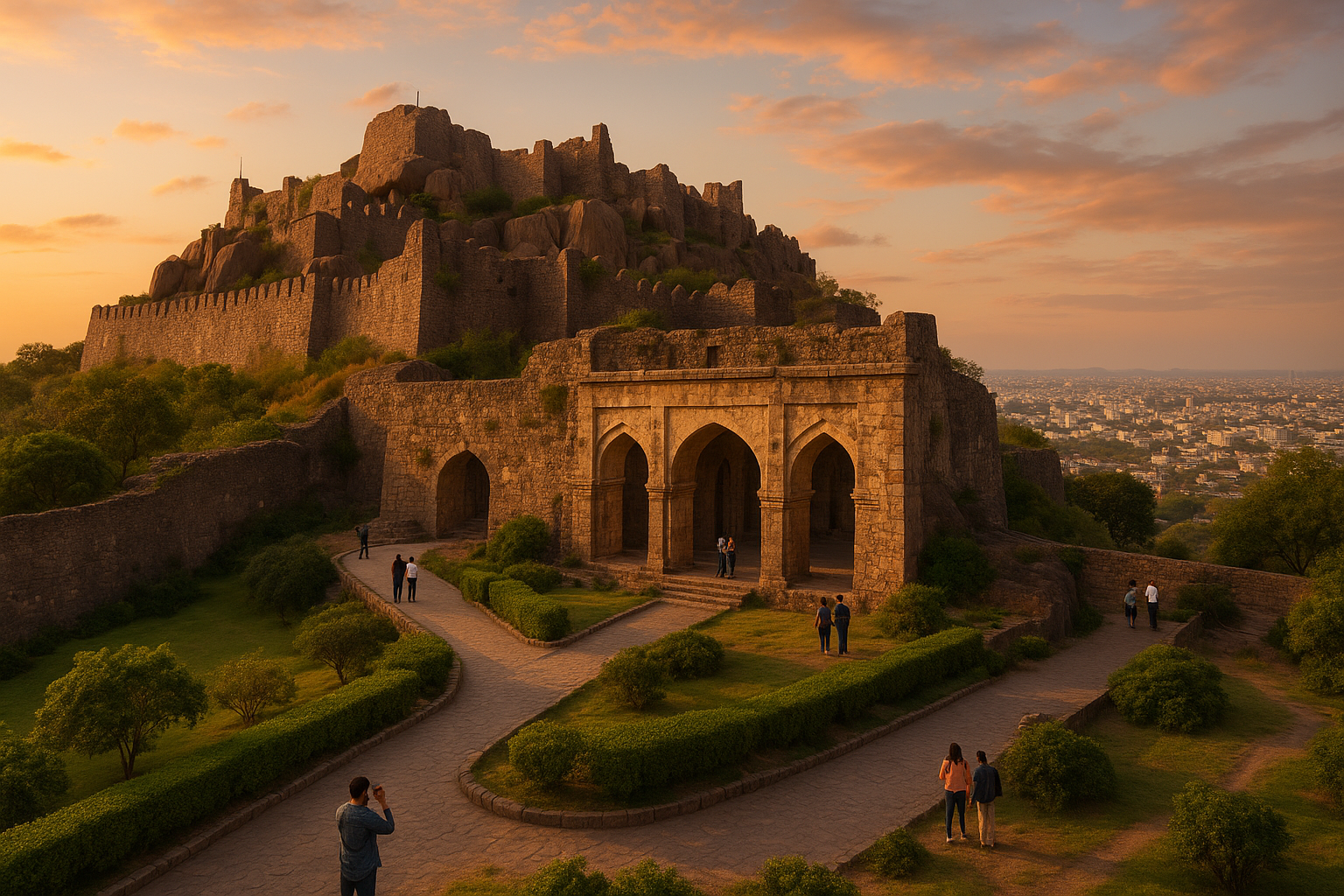
Location: Hyderabad, Telangana Historical Background and Date of Construction: Golconda Fort (derived from “Golla Konda” meaning “Shepherd’s Hill”) has its origins in the Kakatiya Dynasty, dating back to the 12th-13th century, initially as a mud fort. It was later developed significantly by the Bahmani Sultans and then rose to prominence under the Qutb Shahi dynasty, who transformed it into a formidable stone fortress and their capital in the 16th century.
Dynasties or Kings Who Built and Ruled It:
- Kakatiya Dynasty: Initial mud fort.
- Bahmani Sultanate: Developed the fort.
- Qutb Shahi Dynasty: The most significant builders, making it their capital. Ibrahim Quli Qutb Shah and Muhammad Quli Qutb Shah were instrumental in its expansion.
- Mughals: Conquered it after a long siege.
Architectural Style and Special Features: Golconda Fort is a magnificent example of Indo-Islamic (Deccani) architecture, known for its unique acoustic features and strategic design.
- Acoustic System: One of its most fascinating features is the acoustic design: a clap at the main entrance (Fateh Darwaza) can be heard distinctly at the Bala Hissar Pavilion, the highest point of the fort, about 1 kilometer away. This served as an early warning system.
- Strong Walls and Gates: Enclosed by massive granite walls, nearly 7 km in circumference, with 87 semicircular bastions and eight imposing gates.
- Water Management: Sophisticated water supply system, including wells, reservoirs, and channels, to cater to the fort’s inhabitants.
- Palaces and Halls: Remnants of palaces like the Durbar Hall, Ramdas’s Prison (a legendary structure), and various royal apartments.
- Fath Darwaza (Victory Gate): The main entrance, historically significant for Aurangzeb’s entry after his conquest.
- Tomb of Qutb Shahi Kings: Located nearby, these elaborate tombs reflect the architectural style of the dynasty.
Important Battles or Historical Events:
- Diamond Mines: Golconda was renowned for its diamond mines, which produced some of the world’s most famous diamonds, including the Koh-i-Noor, Hope Diamond, and Daria-i-Noor.
- Aurangzeb’s Siege (1687): The fort famously resisted Mughal Emperor Aurangzeb’s siege for eight months before finally falling due to treachery, marking the end of the Qutb Shahi dynasty.
Current Condition and Conservation Status: The fort is largely in ruins but well-preserved by the ASI. It is a popular historical site.
Tourism and Visitor Information:
- Sound and Light Show: A popular evening attraction that narrates the fort’s history.
- Acoustic Clap: Visitors often try the famous acoustic clap at the entrance.
- Accessibility: Easily accessible from Hyderabad city.
6. Red Fort, Delhi
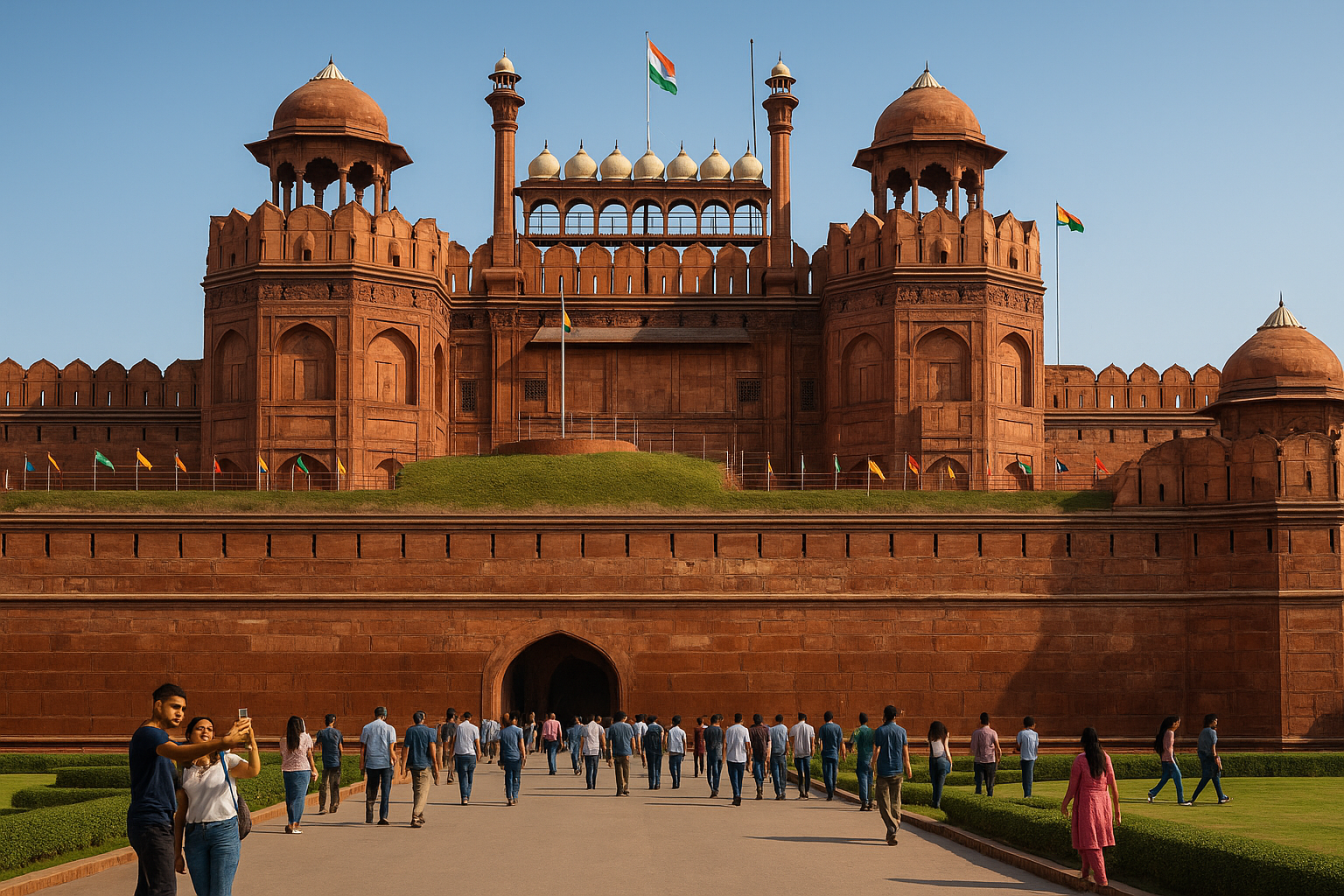
Location: Delhi (Old Delhi) Historical Background and Date of Construction: The Red Fort (Lal Qila) was built by the Mughal Emperor Shah Jahan when he decided to shift his capital from Agra to Delhi and establish the new city of Shahjahanabad. Construction began in 1639 and was completed in 1648.
Dynasties or Kings Who Built and Ruled It:
- Mughal Dynasty: Built by Emperor Shah Jahan. It served as the principal residence of the Mughal emperors for nearly 200 years, from Shah Jahan to Bahadur Shah Zafar.
Architectural Style and Special Features: The Red Fort is an outstanding example of Mughal architecture, blending Persian, Timurid, and Indian architectural styles. It is a UNESCO World Heritage Site (2007).
- Massive Red Sandstone Walls: The fort is enclosed by towering walls of red sandstone, giving it its name, extending over 2.5 kilometers.
- Lahori Gate and Delhi Gate: The two main ceremonial entrances, both grand and fortified.
- Diwan-i-Aam (Hall of Public Audience): Where the emperor met common people, featuring a spectacular peacock throne.
- Diwan-i-Khas (Hall of Private Audience): For private meetings, exquisitely decorated with floral motifs, marble inlay work, and famous for the inscription “If there is Paradise on Earth, it is this, it is this, it is this.”
- Rang Mahal (Palace of Colors): The emperor’s wives and mistresses lived here, known for its painted interiors and central marble fountain.
- Moti Masjid (Pearl Mosque): A small, elegant mosque built by Aurangzeb for his personal use, made of white marble.
- Naubat Khana (Drum House): Where royal musicians played.
- Water Channel (Nahr-i-Behisht): A canal flowing through the private apartments, symbolizing the “Stream of Paradise.”
- Mumtaz Mahal (now a museum): Initially a part of the imperial harem, now houses the Delhi Fort Archaeological Museum.
Important Battles or Historical Events:
- Nadir Shah’s Invasion (1739): Persian invader Nadir Shah sacked Delhi and carried away the Peacock Throne from the Diwan-i-Aam.
- Indian Rebellion of 1857: The Red Fort became a focal point of the rebellion. After the rebellion was suppressed, the British exiled Bahadur Shah Zafar, the last Mughal Emperor, effectively ending Mughal rule.
- India’s Independence: On August 15, 1947, India’s first Prime Minister, Jawaharlal Nehru, hoisted the national flag at the Lahori Gate, a tradition continued by subsequent Prime Ministers on Independence Day.
Current Condition and Conservation Status: The Red Fort is a protected monument under the ASI and is a UNESCO World Heritage Site. Significant portions are well-preserved, though some inner structures have deteriorated over time or were altered by the British.
Tourism and Visitor Information:
- Independence Day Celebrations: The most iconic event held here annually.
- Sound and Light Show: Depicts Mughal history.
- Museums: Several museums within the complex.
- Accessibility: Centrally located in Old Delhi, easily accessible by Delhi Metro.
7. Jaisalmer Fort, Jaisalmer, Rajasthan
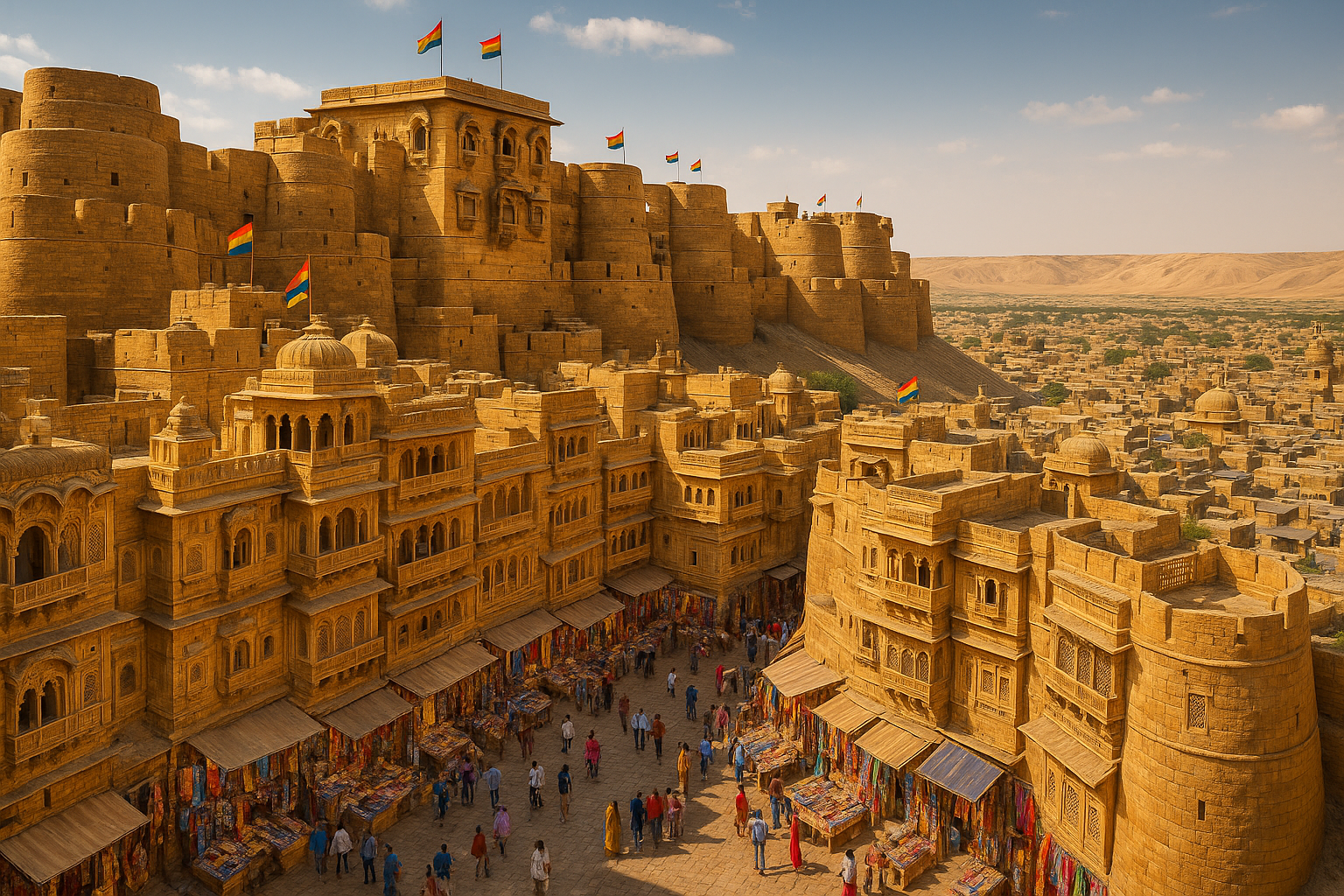
Location: Jaisalmer, Rajasthan Historical Background and Date of Construction: Jaisalmer Fort, also known as Sonar Qila (Golden Fort) due to its appearance in the setting sun, was built in 1156 AD by Rawal Jaisal, a Rajput ruler from whom the city derives its name. It is one of the few “living forts” in the world, meaning a significant portion of the city’s population still resides within its walls.
Dynasties or Kings Who Built and Ruled It:
- Bhati Rajput Rulers: Built and continuously ruled by the Bhati clan of Rajputs, who traced their lineage to the Yaduvanshi Rajputs. Rawal Jaisal, Rawal Gaj Singh, and other subsequent rulers fortified and expanded it.
Architectural Style and Special Features: Jaisalmer Fort is a striking example of Rajput military architecture, built entirely in yellow sandstone, which gives it its golden hue. It is part of the Hill Forts of Rajasthan UNESCO World Heritage Site (2013).
- Unique Location: Perched on Trikuta Hill, overlooking the Thar Desert.
- Defensive Walls: The fort is protected by three layers of walls, designed to withstand sieges in the harsh desert environment. The outer layer acts as a solid base for the inner layers.
- Four Gates: Including Ganesh Pol, Suraj Pol, Bhuta Pol, and Hawa Pol.
- Royal Palace (Maharawal Palace): A complex of former royal residences with intricate carvings and jharokhas (balconies).
- Jain Temples: A cluster of beautifully carved Jain temples dating from the 12th to 15th centuries, showcasing exquisite Dilwara-style architecture.
- Laxminath Temple: A prominent Hindu temple dedicated to Lakshmi and Vishnu.
- Havelis: Numerous ornate havelis (mansions) built by wealthy merchants, such as Patwon ki Haveli, Salim Singh ki Haveli, and Nathmal ki Haveli, are outside the fort but reflect the same intricate sandstone craftsmanship.
Important Battles or Historical Events: Jaisalmer Fort faced several sieges from powerful adversaries like the Delhi Sultanate (Alauddin Khalji in the late 13th century) and the Mughals. The Bhati Rajputs often employed guerrilla tactics and resilience to protect their desert stronghold.
Current Condition and Conservation Status: As a “living fort,” it faces unique challenges related to sewerage, drainage, and maintaining its historic fabric while accommodating modern life. Conservation efforts are ongoing by ASI and local heritage bodies, but the continuous habitation poses complex issues for preservation. It’s a UNESCO site, providing some level of protection and funding.
Tourism and Visitor Information:
- Living Heritage: Visitors can experience life within a historic fort, with shops, guesthouses, and restaurants operating inside.
- Desert Views: Offers spectacular views of the Thar Desert, especially at sunset.
- Jain Temple Architecture: The intricately carved Jain temples are a major draw.
- Accessibility: Well-connected by road and rail to major cities in Rajasthan.
8. Kumbhalgarh Fort, Rajsamand, Rajasthan
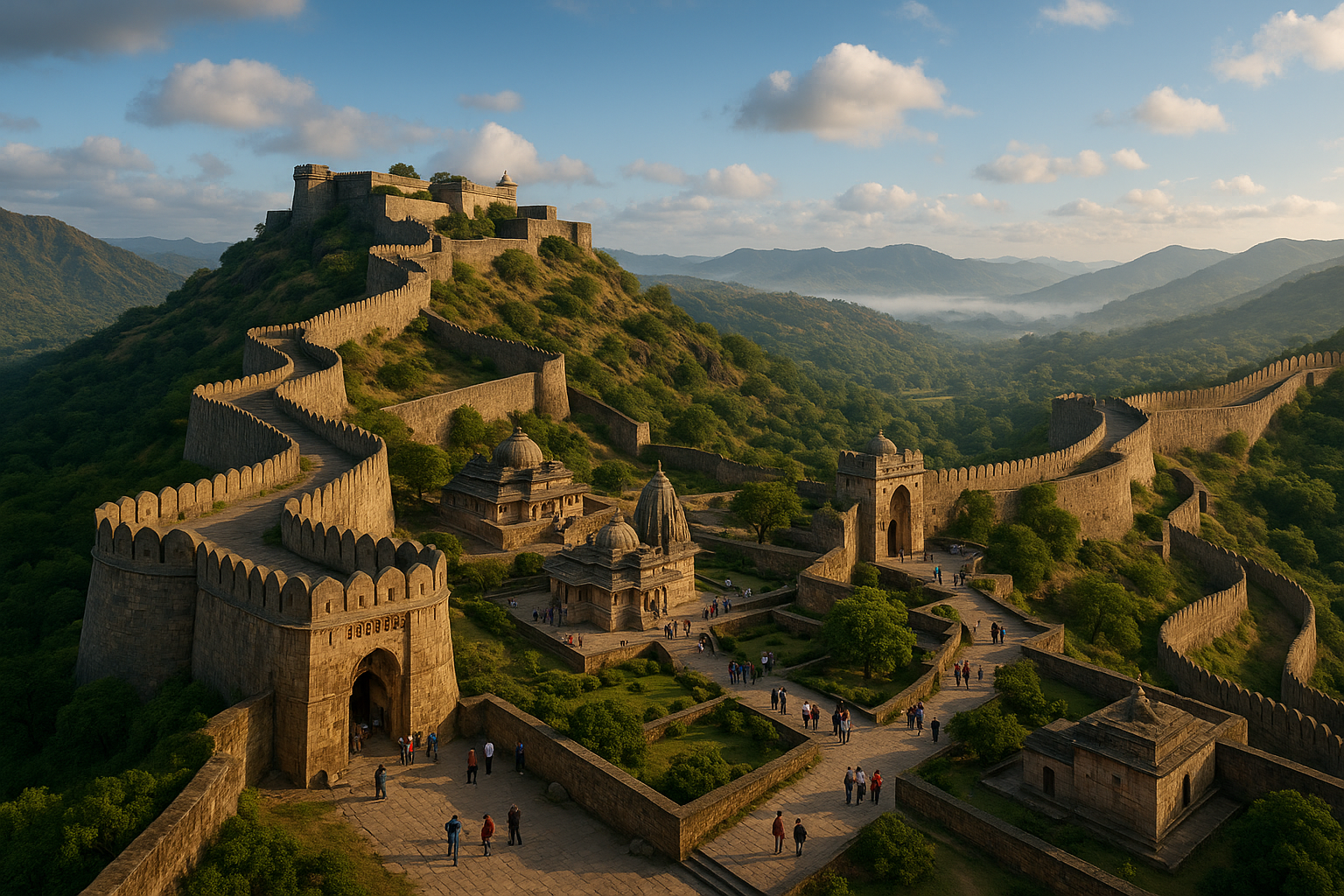
Location: Rajsamand, Rajasthan (about 82 km from Udaipur) Historical Background and Date of Construction: Kumbhalgarh Fort was built during the 15th century by Maharana Kumbha of Mewar. Construction began in 1443 and was completed in 1458. It is renowned for its impressive wall, often called “The Great Wall of India.”
Dynasties or Kings Who Built and Ruled It:
- Sisodia Dynasty of Mewar: Maharana Kumbha was the primary builder. Subsequent Sisodia rulers, including Maharana Udai Singh II (father of Maharana Pratap), who was born here, ruled from Kumbhalgarh.
Architectural Style and Special Features: Kumbhalgarh Fort is a masterpiece of Rajput military architecture, known for its strategic location, massive fortifications, and austere yet powerful design. It is part of the Hill Forts of Rajasthan UNESCO World Heritage Site (2013).
- The Great Wall of India: The most striking feature is its massive defensive wall, stretching over 36 kilometers (22 miles), making it the second-longest continuous wall in the world after the Great Wall of China. The wall is 15 feet wide at places, allowing eight horses to ride abreast.
- Strategic Location: Built on a hilltop 1,100 meters (3,600 ft) above sea level, providing natural defenses.
- Seven Fortified Gates: Including Aret Pol, Hulla Pol, Ram Pol, and Hanuman Pol.
- Palaces:
- Badal Mahal (Palace of Clouds): The highest point of the fort, built by Maharana Fateh Singh, offering panoramic views. It features separate sections for male and female royals.
- Temples: Over 360 temples (both Jain and Hindu) are located within the fort complex, demonstrating the religious tolerance of the rulers. The most notable is the Neelkanth Mahadev Temple.
- Vast Water Reservoirs: Essential for sustaining life during sieges.
Important Battles or Historical Events:
- Impregnable Fortress: Kumbhalgarh was considered virtually impregnable. It fell only once, that too due to a shortage of drinking water, to the combined forces of Emperor Akbar, Raja Man Singh I of Amber, and Raja Udai Singh of Marwar.
- Birthplace of Maharana Pratap: The legendary Rajput warrior, Maharana Pratap, was born within the fort in 1540.
- Refuge for Mewar Rulers: Served as a safe haven for the rulers of Mewar during times of peril, particularly after the fall of Chittorgarh.
Current Condition and Conservation Status: The fort is well-preserved by the ASI and is a UNESCO World Heritage Site, ensuring its continuous maintenance.
Tourism and Visitor Information:
- Light and Sound Show: Held in the evenings, highlighting the fort’s history and Maharana Kumbha’s legacy.
- Trekking: Offers opportunities for trekking along its massive wall.
- Panoramic Views: Breathtaking views of the Aravalli mountain range.
- Accessibility: Accessible by road from Udaipur.
9. Mysore Palace, Mysuru, Karnataka
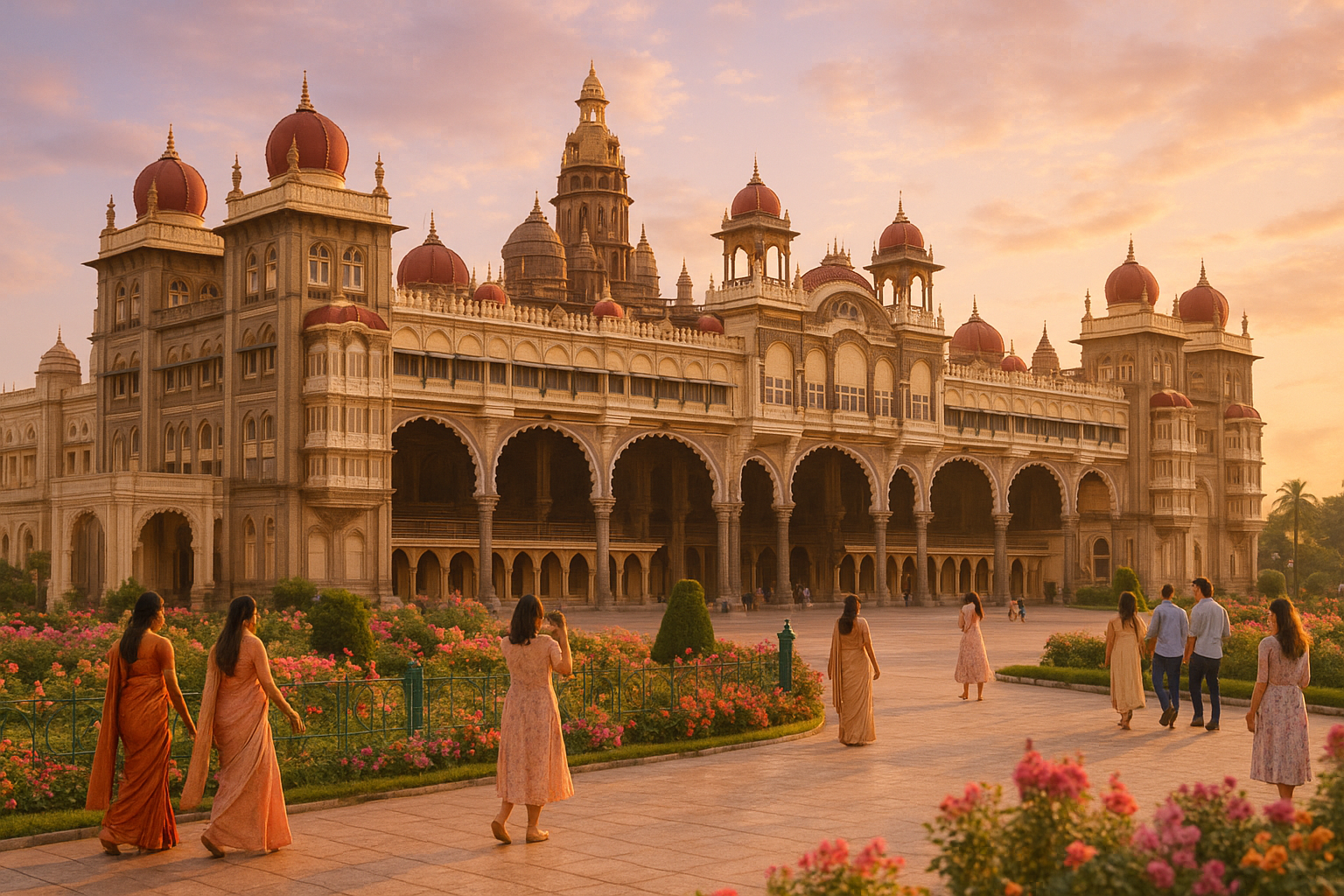
Location: Mysuru, Karnataka Historical Background and Date of Construction: Mysore Palace, officially known as Amba Vilas Palace, is the current royal residence and former seat of the Wadiyar dynasty. The present palace was largely designed by the English architect Henry Irwin and constructed between 1897 and 1912 after the old wooden palace was destroyed by fire during a wedding in 1896. However, the Wadiyar dynasty had its first palace built in Mysore as early as the 14th century.
Dynasties or Kings Who Built and Ruled It:
- Wadiyar Dynasty: The traditional rulers of the Kingdom of Mysore. The present palace was built under Maharaja Krishnaraja Wadiyar IV.
Architectural Style and Special Features: Mysore Palace is a magnificent example of Indo-Saracenic architecture, a fusion of Hindu, Mughal, Rajput, and Gothic styles.
- Grandeur and Scale: A sprawling three-storied stone structure with a deep pink marble dome.
- Durbar Hall (Diwan-e-Aam): A grand hall for public audiences.
- Gombe Thotti (Doll’s Pavilion): A collection of traditional dolls and sculptures.
- Ambavilasa (Diwan-i-Khas): The private audience hall, exquisitely decorated with painted ceilings and mosaic floors. This is where the Maharaja held private meetings.
- Kalyana Mantapa (Wedding Hall): A spectacular octagonal pavilion with a multi-domed roof and a stained-glass ceiling featuring peacock motifs.
- Golden Howdah: The ceremonial golden elephant seat used during the Dasara procession, displayed in the palace.
- Murals and Paintings: The walls are adorned with intricate murals depicting scenes from Indian mythology and royal processions.
- Gardens: Beautifully landscaped gardens surround the palace.
- Illumination: Famous for its nightly illumination with nearly 100,000 bulbs on Sundays and public holidays, creating a mesmerizing spectacle.
Important Battles or Historical Events: While the current palace is relatively recent, the Wadiyar dynasty’s history is steeped in significant events, including the Anglo-Mysore Wars against Tipu Sultan and Haider Ali. The palace itself, particularly the older wooden structure, was a central point of administration and ceremonial events for centuries.
Current Condition and Conservation Status: Mysore Palace is impeccably maintained by the Karnataka State Government and the royal family. It is a major living heritage site.
Tourism and Visitor Information:
- Dasara Celebrations: The palace is the focal point of the grand Dasara festival, especially the Jumbo Savari procession.
- Illumination: A major draw for tourists.
- Museum and Art Gallery: Houses a rich collection of artifacts, paintings, and royal paraphernalia.
- Accessibility: Centrally located in Mysuru, easily accessible.
10. Neemrana Fort Palace, Neemrana, Rajasthan
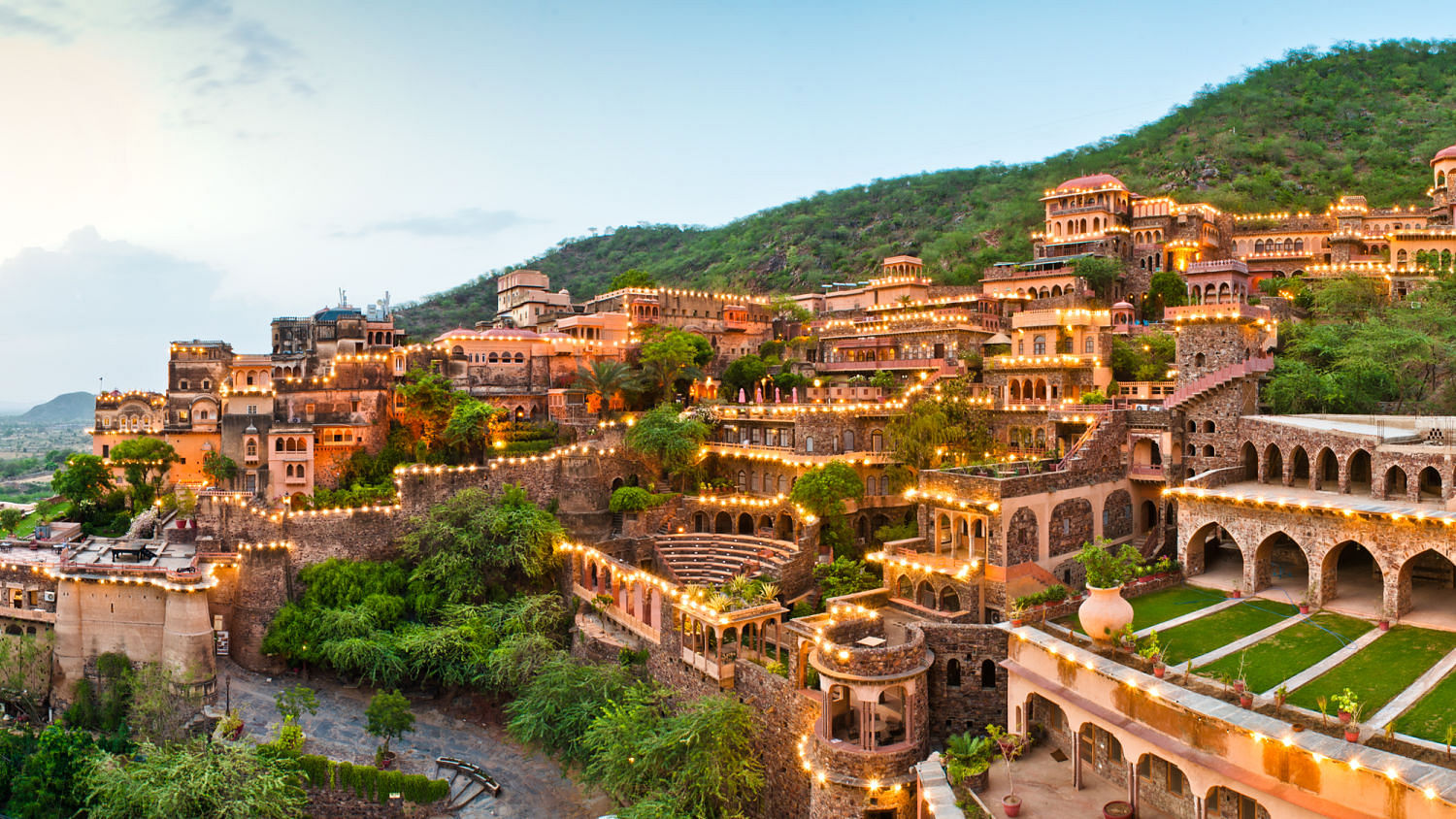
Location: Neemrana, Rajasthan (on the Delhi-Jaipur highway) Historical Background and Date of Construction: Neemrana Fort was built in 1464 AD by the Chauhans, one of the oldest Rajput clans. It served as their capital for centuries. Over time, as its strategic importance waned, it fell into disrepair. In 1986, it was acquired by a private trust and meticulously restored over several decades, transforming it into a heritage hotel.
Dynasties or Kings Who Built and Ruled It:
- Chauhan Rajputs: Built and ruled by the Chauhan clan, specifically the rulers from the lineage of Prithviraj Chauhan III. Raja Dup Raj was a key figure in its early history.
Architectural Style and Special Features: Neemrana Fort Palace is an example of Rajput architectural principles adapted to a defensive structure, now restored to a luxurious heritage hotel while retaining its original charm.
- Terraced Levels: Built into a hill, it features 14 tiered levels and cascading gardens.
- Gates and Walls: Retains its original fortifications and gates, typical of Rajput forts.
- Restored Structures: Features courtyards, residential quarters, and halls, all meticulously restored with traditional craftsmanship.
- Fusion of Old and New: While preserving the historical structure, modern amenities have been seamlessly integrated for guest comfort.
- Panoramic Views: Offers expansive views of the Aravalli hills and the surrounding countryside.
Important Battles or Historical Events: Neemrana Fort, like many Rajput strongholds, witnessed various skirmishes and power struggles within the region. Its strategic location on a trade route made it vulnerable to attacks. However, it is primarily known today for its remarkable transformation from a ruin to a successful heritage conservation project.
Current Condition and Conservation Status: The fort is in excellent condition due to its restoration and conversion into a hotel. It is privately managed, and its conservation is driven by commercial viability and a commitment to heritage preservation.
Tourism and Visitor Information:
- Heritage Hotel: Its primary function is a heritage hotel, offering unique accommodation.
- Ziplining: A popular adventure activity, offering aerial views of the fort.
- Cultural Programs: Often hosts cultural performances and events.
- Accessibility: Conveniently located on the Delhi-Jaipur highway, making it a popular weekend getaway. It’s approximately 122 km from Delhi.
Leave a Reply